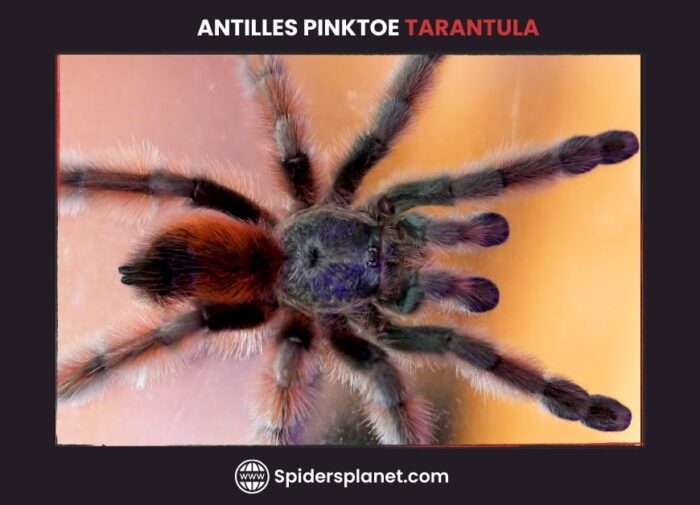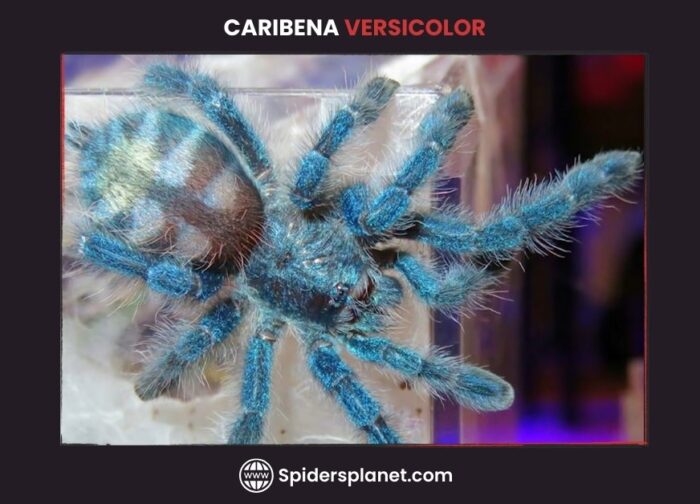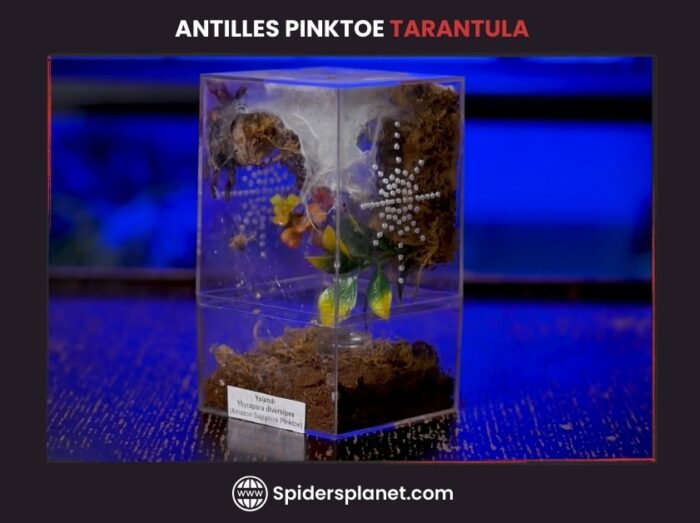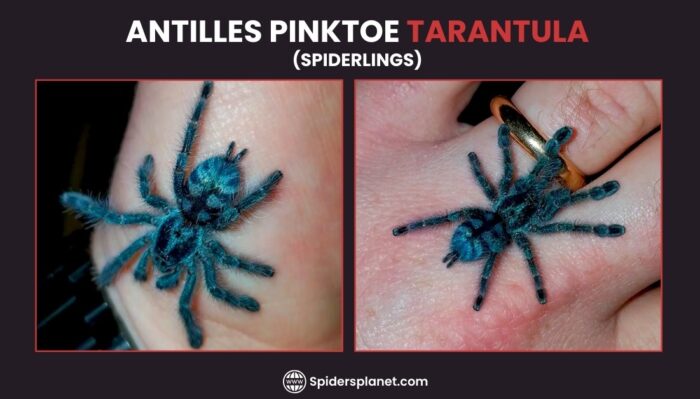Antilles pinktoe tarantula (Caribena Versicolor), Martinique red tree spider, or Martinique pinktoe is the jewel of the Caribbean rainforest with its sparkling colors of a tropical sunset, emerald greens shimmer across its body, fiery oranges blaze on its legs, and its feet dance with a hint of pink.
These spiders are skilled climbers who make intricate webs high up in the trees.
Unlike other spiders, they prefer the nighttime for hunting insects and lizards. Despite their striking looks, they are shy and hide easily.
They can regrow lost limbs, their venom is harmless to humans, and they are quite neat, keeping themselves clean.
Seems fascinating? Want to know more about its appearance, habits and habitat, behavior, diet, life cycle, interesting facts, and considerations for keeping them as pets?
Let’s dive into an educational journey to learn more about these fascinating creatures! Keep reading….!
Interesting Facts About Antilles Pinktoe Tarantula
- Known for their striking and vibrant coloration.
- These tarantulas are native to the Caribbean islands.
- Calm and docile.
- Nocturnal behavior.
- Antilles pinktoes are skilled web builders.
- They molt for growth.
- Popular in the exotic pet trade.
Antilles Pinktoe Tarantula Description:
Scientific Name, Specie, and Family:
The commonly recognized Antilles Pinktoe tarantula or Martinique red tree spider or Martinique pinktoe, scientifically known as Caribena versicolor, Classified under the kingdom Animalia, phylum Arthropoda, class Arachnida, specie C. versicolor, belongs to the family Theraphosidae and the genus Caribena.

Martinique pinktoe, once recognized as Avicularia versicolor, has undergone a recent reclassification and is now placed under the genus Caribena.
Body:
The Antilles pinktoe tarantula is not just a pretty spider but also has a fascinating anatomy that helps it thrive in the rainforest like the cephalothorax (head-chest), legs for moving around, and an abdomen holding organs and silk-making parts.
Special features include hairs that protect it and the ability to grow back lost legs. Its bright colors aren’t just for looks; they help it hide when it is small and scare away predators when it is grown up.
Learning about its body shows how every part helps it live well in the rainforest.
Antilles Pinktoe Tarantula Appearance:
Color:
The spiderlings of Martinique pinktoe initially display a vibrant blue coloration with a distinctive pattern resembling a dark tree trunk on their abdomen.

However, as they mature, they undergo a striking transformation. The once-blue coloration fades, with the carapace turning green, the abdomen adopting a red hue, and the legs changing to green with pink tarsi and a layer of purple hairs.
Males typically exhibit slightly brighter colors than females.
Size:
The Martinique pinktoe, falling under the category of medium growth, demonstrates notable lifespan and size differences between males and females.
Female tarantulas can live approximately 12 years, reaching a size of 5 to 6 inches. In contrast, males have a shorter lifespan of around 2 to 3 years and are generally an inch or two smaller than their female counterparts.
In line with the common pattern in tarantula species, males remain smaller than females, with their abdomens proportionally smaller even in relation to their overall size.
This divergence in lifespan and size is a common characteristic in tarantula species, reflecting distinct life cycles and reproductive patterns between genders.
What They Like to Eat or Hunt?
The Antilles pinktoe tarantula is not a finicky eater. These vibrant arachnids dine on a variety of prey in their rainforest home, including insects like crickets and roaches, occasional small lizards, and even the rare spider.
Their hunting tactics involve building intricate webs for ambush or patiently waiting for prey. A varied diet, depending on age, ensures their nutritional needs are met.
If considering them as pets, providing a diverse and healthy diet, consulting with experts, mimicking natural feeding behaviors, and understanding their ecological role are essential for responsible care.
Habitat and Adaptations:
The Martinique pinktoe lives in the lush islands of Martinique and Guadeloupe. These islands have lots of tall trees, green vines, and humid air, creating a perfect home for these special spiders.
Unlike some other spiders, Antilles pinktoe tarantulas love to live in trees. They craft intricate funnel-shaped webs, showcasing their arboreal lifestyle in the treetops of the Caribbean rainforest.

These tree-dwelling spiders are quite skilled at crafting these intricate webs, creating a cozy home up in the branches. They hide in safe spots like tree bark and even old bird nests.
In their tree home, they share space with many other small animals like insects and lizards.
The colors of these spiders help them hide in the trees, making them hard for other animals to see. But, their beautiful home is facing problems like trees being cut down and the weather changing.
We need to take care of their home to make sure these amazing spiders and their colorful rainforest stay safe for a long time.
Behavior:
These spiders are shy and prefer the nighttime, where they skillfully climb trees and hunt prey with their intricate webs.
They patiently wait for unsuspecting insects in their silk traps, showcasing an ambush strategy. Molting is vital for Antilles tarantulas’ growth, rendering them temporarily vulnerable before emerging larger and more vibrant.
Surprisingly clean, they groom themselves meticulously with their pedipalps. Communication happens through vibrations, and they possess the incredible ability to regenerate lost limbs, ensuring resilience in their arboreal lifestyle.
Nocturnal Behavior:
This tarantula is a nighttime dweller, most active when the sun goes down. Their vibrant colors, like emerald greens and fiery oranges, shine in the moonlight.
This nocturnal lifestyle helps them spot prey easily and stay hidden from predators in the rainforest canopy.
Reproduction, Babies, and Life Cycle:
The Martinique pinktoe has a fascinating life journey. It starts when the mother spider makes a small ball with lots of tiny eggs (50-200) inside.
When the eggs hatch, tiny spiders, called spiderlings, come out, and they look blue. As they grow up, they molt or shed their skin many times, and their colors change to green and orange.

After a few years, they become adults by going through a special molt. The grown-up males and females dance to have babies, and the mom takes good care of her eggs until they hatch.
The baby spiders stay with their mother for a bit, learn important skills to survive, and then go out on their own in the rainforest. This whole cycle is amazing and adds to the magic of the rainforest.
Lifespan:
Female tarantulas can have a lifespan of approximately 12 years, showcasing a relatively longer lifespan compared to their male counterparts, who typically have a life expectancy of around 3 years.
Predators:
Include birds, snakes, and mantids. Ground threats come from monkeys, raccoons, and occasional cannibalism.
Bite and Venom:
The Caribena versicolor is generally docile and rarely bites. Their mild venom, as mild as a bee sting, poses minimal risk to humans.
Responsible handling, avoiding sudden movements, and understanding their behavior are key to safe interaction.
While they are fascinating creatures, potential owners should prioritize proper care and consider the responsibilities of keeping them as pets.
Antilles Tarantula As Pet?
Owning an Antilles tarantula can be a unique and fascinating experience, but it comes with both pros and cons.
They are easy to care for, show interesting behaviors, and are usually calm, making them a good pet choice.
However, it is important to note that they are a long-term commitment, with a lifespan of 10-20 years, and require specialized care.
Safety considerations, such as their mild venom, must be taken into account, and ethical concerns about the pet trade highlight the importance of sourcing from responsible breeders.
Prospective owners should carefully weigh these factors before deciding to bring an Antilles pinktoe into their home.
Enclosure:
- For C. versicolor tarantulas, the ideal enclosure depends on their life stage.
- For spiderlings, use large dram vials with drilled ventilation holes, moist substrate, and climbing accessories like twigs or cork bark.
- For juveniles, use basic acrylic arboreal enclosures with more height than width. Drill cross-ventilation holes on opposite sides just over halfway to ⅔ up the enclosure to provide ample air circulation.
- For adults, larger clear acrylic or modified glass enclosures work well. Ensure cross ventilation, replacing screen tops with plexiglass to prevent escape or injury. Keep substrate dry, providing a spacious water dish for natural humidity maintenance.
This enclosure strategy has proven successful, promoting the well-being of C. versicolor tarantulas through various life stages.
Care:
To care for Caribena versicolor:
- Use a spacious terrarium (20-25 cm wide, 20-25 cm deep, 30-40 cm high).
- Maintain high humidity by placing moss at the bottom and a substantial substrate layer.
- Keep temperatures between 25-28°C during the day and 20-24°C at night, with good lighting.
Feed every 7-10 days, adjusting based on age and size. Offer crickets, roaches, or suitable insects. Spray the web twice a week for hydration, and consider a water bowl for additional moisture.
Remember, each tarantula is unique, so adjust conditions as needed. Caribena versicolor enjoys a diet of small insects, and their lifespan ranges from 4-10 years, influenced by various factors.
FAQs:
Are Antilles pinktoe tarantulas poisonous?
Yes, they are venomous, but their venom is considered mild and not usually fatal to humans.
How big do Antilles pinktoe tarantulas get?
Females can grow up to 5-6 inches in body length, while males are slightly smaller at around 1-2 inches. Their leg span can reach up to 8-10 inches.
Can you hold Antilles pinktoe tarantulas?
It is crucial to research proper handling techniques and understand their potential for defensive bites. Remember, they are wild animals and not always comfortable with human interaction.
Do Antilles tarantulas harm you?
Antilles pinktoes are not aggressive and will only bite as a last resort if they feel threatened or cornered. Their venom poses minimal risk to healthy humans, and they generally prefer to flee or play dead if scared.
Are Antilles tarantulas aggressive?
No, they are generally docile and unlikely to exhibit aggression towards humans unless provoked.
Pink toe tarantula types?
Pink toe tarantulas fall into two main categories: the widely recognized Antilles Pinktoe (Caribena versicolor) with its striking colors, and the Avicularia Pinktoes, a group within the Avicularia genus, showcasing various vibrant species like the Guyana, Trinidad, and Erufu Pinktoes, each with distinct colorations and charm.
Final Thoughts:
The Antilles Pinktoe Tarantula (Caribena versicolor) is a captivating arboreal species with vibrant colors and fascinating behaviors.
Whether observed from afar or kept as a pet, understanding their unique characteristics, habitat, and care requirements is essential for responsible ownership.
Their jewel-like appearance and the intricate details of their life cycle make them a mesmerizing representation of the biodiversity found in the Caribbean rainforest.
I hope this guide will help you to understand this unique spider and its behavior and to keep them safe as pets.




Leave a Reply